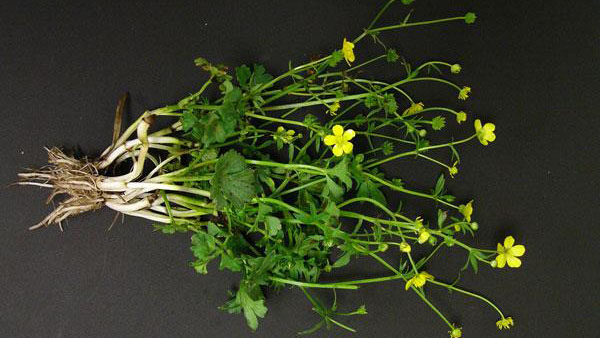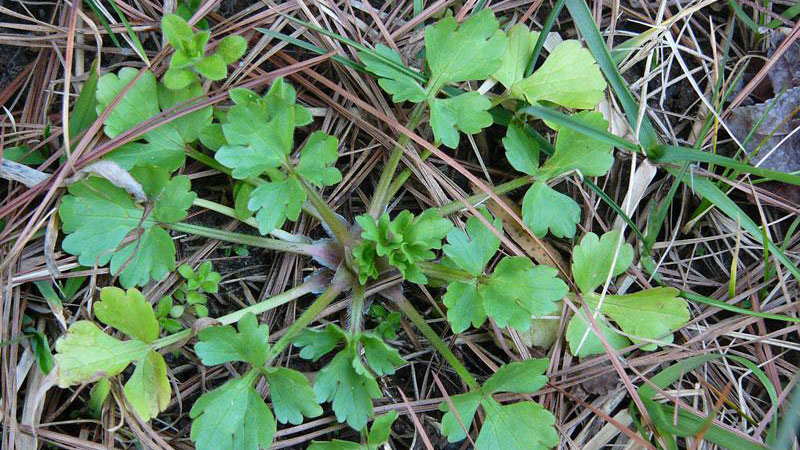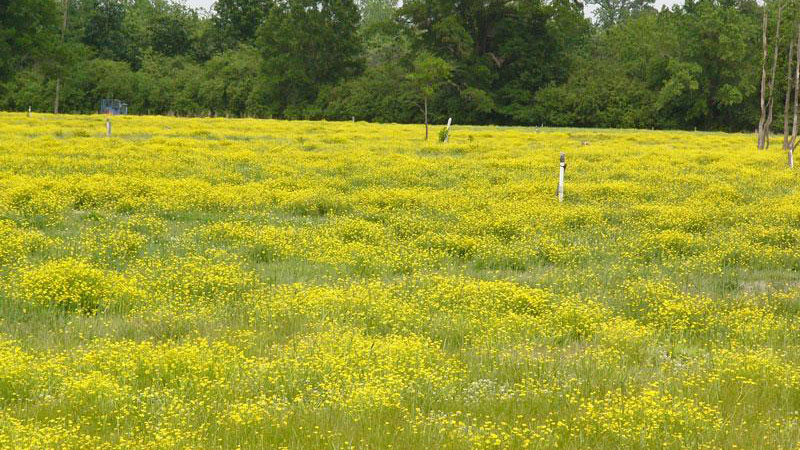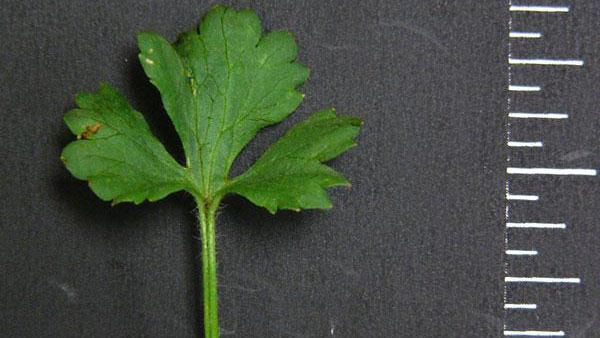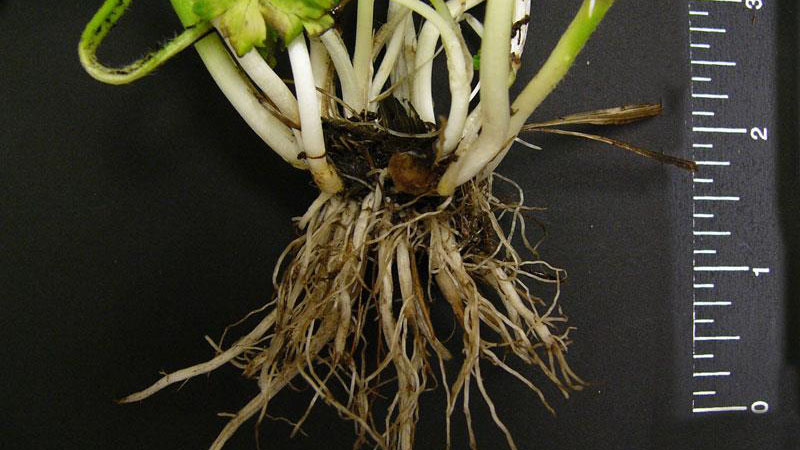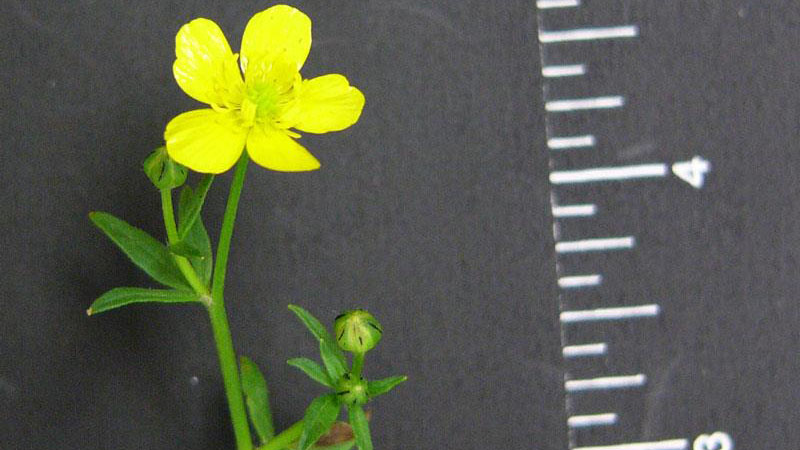Description
Two of the common buttercups found in North Carolina are hairy buttercup (Ranunculus sardous) and bulbous buttercup (Ranunculus bulbosus). Hairy buttercup appears to be predominant in the Piedmont and Mountain regions, while bulbous buttercup is readily found in the Piedmont and Coastal Plain regions. Vegetative characteristics of bulbous buttercup are similar to those of hairy buttercup except for the bulb-like swelling at the base of the stem. This swelling is roundish and white, slightly flattened at the top and bottom. Smallflower buttercup is also found in North Carolina. Whereas bulbous and hairy buttercup have lobed leaves, most of the lower leaves of smallflower buttercup are unlobed.
Cultural Control
Perennial broadleaf turf weeds are capable of living more than two years. They thrive in weak, thin turf; golf fairways and roughs; home lawns; playfields; and industrial grounds. Proper turf maintenance is the key to control of this weed. First, select adapted turfgrass cultivars for your area and then properly fertilize, mow, and water to encourage dense growth.
Chemical Control
| Herbicide and Formulation | Amount of Formulation per 1,000 sq ft | Amount of Formulation per Acre | Pounds Active Ingredient per Acre |
| Preemergence and Postemergence Control | |||
| mesotrione, MOA 27 (4 SC) (Tenacity) | 0.092 to 0.183 fl oz | 4 to 8 fl oz | 0.125 to 0.25 |
| Precaution and Remarks: Use on residential turf, golf courses (not greens) and sod farms for pre- and postemergence weed control. Tolerant turfgrasses include St. Augustinegrass, centipedegrass, tall fescue, fine fescue, Kentucky bluegrass, and perennial ryegrass. Add a nonionic surfactant and repeat application after 2 to 3 weeks for improved postemergence control. Tank mix with prodiamine 65 WG for extended preemergence grassy weed control. Can be applied at seeding to all tolerant grasses except fine fescue. After turf germination, wait 4 weeks or until turf has been mowed twice before making a postemergence application. Also controls henbit, chickweed, dandelion, white clover, Florida betony, Florida pusley, ground ivy, oxalis, wild violet, creeping bentgrass, and yellow nutsedge. | |||
| [sulfentrazone + prodiamine], MOA 14 + 3 (4 SC) (Echelon) | 0.184 to 0.826 fl oz | 0.5 to 2.25 pt | 0.25 to 1.125 |
| Precaution and Remarks: For use in residential and institutional lawns, athletic fields, sod farms, golf course fairways and roughs, roadsides, utility right-of-ways, railways, and industrial areas. Apply to turf following a second mowing if a good root system has been established. Apply up to 12 fluid ounces per acre to bentgrass at 0.5 inch or higher, fine fescue, and perennial ryegrass. Apply 18 to 24 fluid ounces per acre to perennial bluegrass, tall fescue, and all warm season grasses except St. Augustinegrass (do not apply) and bermudagrass (apply 18 to 36 fluid ounces per acre). For sod production, apply 6 months after establishment, and do not harvest within 3 months. Do not apply with adjuvants or surfactants. [Sulfentrazone + prodiamine should not be applied to cool-season turf with N-containing fertilizers unless some short-term discoloration is tolerable. | |||
Species Data
- GROWTH SEASON / LIFE CYCLE
- winter annual or perennial weed
- GROWTH HABIT
- LEAFLET NUMBER
- one
- LEAF MARGIN
- LEAF HAIRS
- dense hairs on upper surface
- LEAF / LEAFLET SHAPE
- oval / egg-shaped / elliptical
- LEAF WIDTH
- 1⁄2 - 2 inches
- LEAF VENATION
- palmate
- LEAF ARRANGEMENT
- alternate
Figure 7
- alternate
- ROOT TYPE
- bulbous
Figure 8
- bulbous
- FLOWER COLOR
Publication date: Nov. 20, 2017
N.C. Cooperative Extension prohibits discrimination and harassment regardless of age, color, disability, family and marital status, gender identity, national origin, political beliefs, race, religion, sex (including pregnancy), sexual orientation and veteran status.


